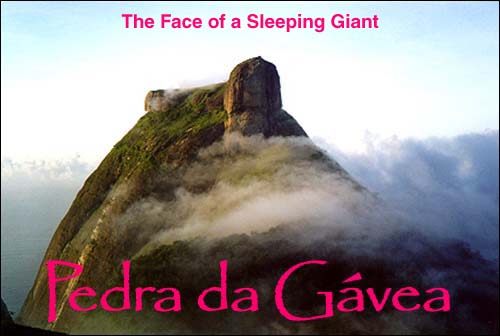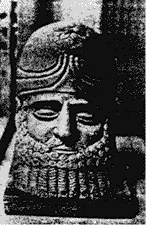
By Luiza Becari, Viewzone Brazil
|
High atop a coastal mountain, this huge and largely unknown carving of an ancient face reminds explorers of the Sphinx in Egypt. Mysterious inscriptions give clues in an extinct language. Could this be a link to our forgotten past?
Between São Conrado and Barra da Tijuca, Rio de Janeiro, a legendary mountain with the face of an ancient giant rises 842 meters above the sea level. When Brazil was discovered, Portuguese explorers gave the rock the name of Gávea, because it was a perfect observatory for in-coming Caravels (the ships used by them to cross the ocean and get to the American continent).
But Pedra da Gávea, an enormous rock surrounded by native, exuberant vegetation, has enticed the minds of both the public and historians over the centuries. Its face looks like a carved figure, and there are ancient inscriptions on one of its sides that couldn't possibly have been made by nature. The origins of those carvings have been discussed over the years, but no one can prove who made them and why.
The Phoenician tomb theory:
According to Pedro Lacaz do Amaral, an experienced climber-guide of Live to Climb that climbed the rock a number of times, the rock is supposedly the burial place of Phoenician king. To support this theory, he sent us clippings of very reputable and popular magazines and newspapers, which covered the various attempts to discover such grave and the real story behind the legend of the Pedra da Gávea. According to him, this legend is well known among Brazilians and he, too, thinks the engravings couldn't have been made by nature alone, as some experts say.
Exploration
It all starts in the XIX century. Some "signs" on the side of the rock called the attention of the emperor, D. Pedro I, although his father, D. Joáo VI, King of Portugal, had already received a report from a priest telling him about the strange marks, which dated back to before 1500, when Brazil was discovered. Until 1839 official research was conducted, and in March, 23rd, in its 8th extraordinary section, the Geographic and Historical Institute of Brazil decided that the Pedra da Gávea should be thoroughly analyzed, and ordained then the local study of the site of the inscriptions. A small commission was formed to study the rock, but some 130 years later, O Globo, a major and very reputable newspaper, questioned such commission, asking if they really climbed the rock or simply studied it using binoculars. The report given by the research party said they "saw the inscriptions and also some depressions made by nature". However, anyone seeing those marks closely will agree that no natural phenomenon could ever have caused those inscriptions to appear.
After the first report, no one talked about the rock again officially until 1931, when a group of excursionists formed an expedition to find the tomb of a Phoenician king that was enthroned in 856 B.C. Some amateurish excavations were made with no results. Two years later, in 1933, a climbing club from Rio organized a gigantic expedition with 85 climbers, which had the participation of Prof. Alfredo dos Anjos, a historian that gave them an "in loco" lecture about the "Head of the Emperor" and its origins.

On January 20th,1937 that same club organized another expedition, this time with a bigger number of participants, with the goal of exploring the face and the eyes of the head down from the top, using ropes. That was the first time someone explored that part of the rock after the Phoenicians, if the legend is true. In 1946, according to an article written in 1956, the Brazilian Excursionists Center conquered the right ear of the head, which is located at an inclination of 80 degrees from the ground and at a very difficult place to reach. Any mishaps and it would be a 20-meter, fatal free fall for the climbers. This first West Side climbing, although almost vertical, was made virtually "by finger nails". There, at the ear, there's the entry of a grotto, which leads to a long and very narrow underground cave that goes all the way to the other side of the rock. In 1972 climbers from the "Equipe Neblina" climbed the "Paredáo do Escaravelho", the wall on the east side of the head, and crossed with the inscriptions, which lay about 30 meters down from the top in a very hard to access place. Although Rio has a high annual rate of rainfall, the inscriptions were still almost intact. In 1963 an arqueologist and professor of scientific ability called Bernardo A. Silva Ramos translated them as: LAABHTEJ BAR RIZDAB NAISINEOF RUZT
Read backwards: Tyro Phoenicia, Firstborn Jethbaal.
The big head with two eyes (not very deep and with no communication between them) and ears; The enormous rocks on the top of the head which resemble a sort of crown or adorn; An enormous cavity in the shape of a portal in the north-east part of the head that is 15 meters high, 7 meters wide and 2 meters deep; An observatory on the South-east part like a dolmen, containing some engravings; A culminating point like a small pyramid made of one single block of stone on the top of the head; The famous and controversial inscriptions on the side of the rock; Some other small inscriptions resembling snakes, sun-rays and etc, located throughout the top of the mountain; The site of a supposed nose, which would have fallen off long ago. Roldáo Pires Brandáo, the president of the Brazilian Association of Speleology and Archeological Research in Rio and one of the many Pedra da Gávea fans said: "It is a sphinx engraved in granite by the Phoenicians, which has the face of a man and the body of a laid animal. The tail must have fallen because of the action of time. The rock, seen from far away, has the grandeur of the Pharaonic monuments and reproduces, in one of its sides, the severe face of a patriarch." (O Globo)
Other sites were found in Niterôi, Campos e Tijuca that suggest that the Phoenicians were indeed there. In an Island on the coast of Paraéba, another state of Brazil very far from Rio, cyclopean rocks and ruins of an ancient castle with enormous rooms and extensive corridors and passageways was found. According to some experts the castle would be a relic left by the Phoenicians, although there are people that contest such conclusions. Robert Frank Marx, an American archeologist interested in finding proofs of pre-Columbian navigation in Brazil, started in October, 1982 a series of divings in the bay. He wanted to find a sunken Phoenician ship and prove that the Brazilian coast has been, in remote times, visited by oriental civilizations. Although he didn't find such vessel, what he encountered there could be considered as a valuable treasure. About this search, O Globo published:
"The case of the Phoenician pottery in the Guanabara Bay was always treated with major secrecy and its founding was only revealed a year later, in 1978, by vague information. The name of the diver who found the twelve archeological pieces was only revealed yesterday, after a conference in the Marine Museum, by the president of the Professional Association for Sub-acquatic Activities, Raul Cerqueira."Three vases were found. One remained with José Roberto teixeira, the diver who found the vases, and the other two went to the Marines. The pieces, with capacity to hold 36 liters, are under the guard of the Brazilian government in secret location.
|

Other history related articles on this site:
.
.
.
.
.
.
.
.
.
.
.
.
If you have a suggestion or history related article to submit, send it to:
Editor/viewzone.com
myristicin@hotmail.com
 Some of the facts that led to the many stories about the rock:
Some of the facts that led to the many stories about the rock: It is known today that in 856 BC Badezir took his father's place in the royal throne of TYRO. Is the Pedra da Gávea the grave of this King? The picture on the left shows what the sphinx would have looked like when it was made.
It is known today that in 856 BC Badezir took his father's place in the royal throne of TYRO. Is the Pedra da Gávea the grave of this King? The picture on the left shows what the sphinx would have looked like when it was made.